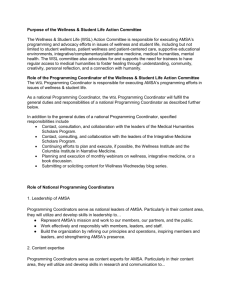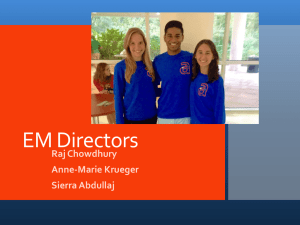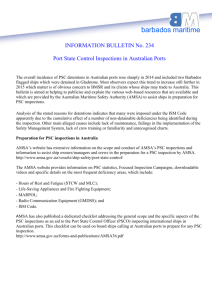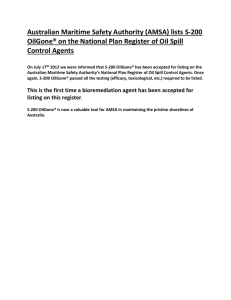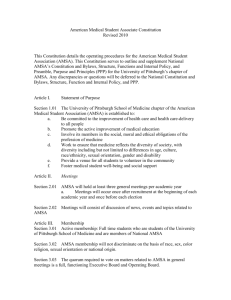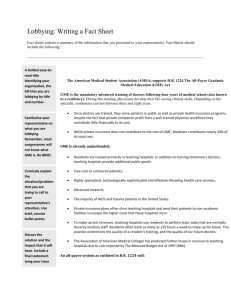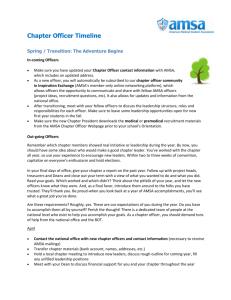Promoting diversity within AMSA's workforce DIVERSITY PLAN
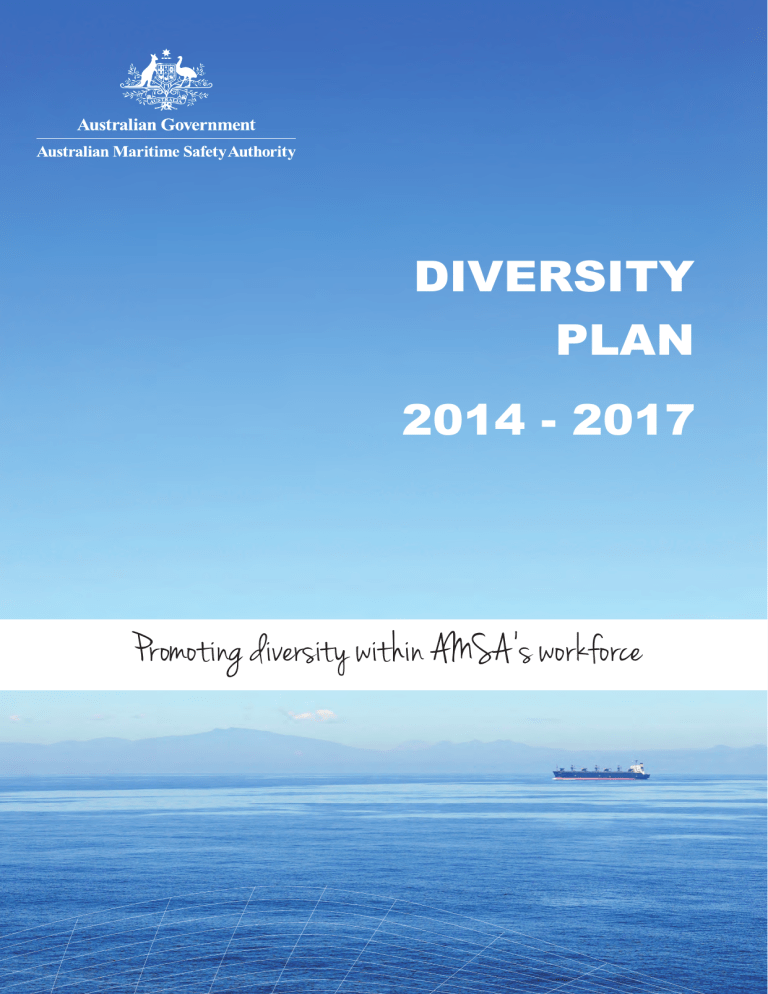
DIVERSITY
PLAN
2014 - 2017
Promoting diversity within AMSA’s workforce
Page 2 of 25
Foreword from the
CEO
The Australian Maritime Safety Authority (AMSA) is an equal opportunity employer that encourages diversity across our workforce. At AMSA, we acknowledge the value diversity can bring to assist us in delivering against our mission to contribute towards ‘safe shipping, clean seas and saving lives’.
High performing organisations need to be able to access, develop and retain the skills and abilities of all Australians, regardless of their gender, race, religion, sexual preferences, disability status or other individual differences. AMSA must ensure that our workforce continues to represent the diversity of the Australian community in which we serve.
I am pleased to present the AMSA Diversity Plan 2014-2017 . This plan will continue to build on the positive steps which have already taken place throughout AMSA to promote and harness the value diversity can bring to our workforce. The plan also identifies areas in which AMSA can focus in order to improve our diversity, specifically in relation to the employment and retention of
Aboriginal and Torres Strait Islander people, women and an intergenerational workforce.
I encourage all AMSA employees to become familiar with the plan and to play an active role in promoting the important initiatives included, that will continue to positively strengthen our workplace diversity into the future.
Mick Kinley
Chief Executive Officer
October 2014
Page 3 of 25
Page 4 of 25
Contents
Introduction 7
Our operational context 8
The benefits of a Diverse Workforce
Why we need a Diversity Plan
How we will measure our progress
9
10
11
1. Workplace diversity across AMSA – organisation wide efforts
2. Aboriginal and Torres Strait Islander People
3. Women in the workplace
4. People with a disability
5. Understanding and responding to the needs of an intergenerational workforce
6. People from culturally and linguistically diverse backgrounds
7. Gay, Lesbian, Bisexual, Trans and Intersex people
20
22
24
12
14
16
18
Page 5 of 25
Page 6 of 25
Introduction
The AMSA Workforce Strategy 2012-2017 provides the context for the development of this plan, with the aim of increasing the reach of AMSA’s current diversity initiatives and focusing on removing barriers that prevent workplace participation and progression for people from a range of diversity groups. AMSA is committed to supporting initiatives that promote workplace diversity and the development and implementation of the AMSA Diversity Plan 2014-2017 will allow us to continue to strengthen the diversity of our workforce.
Workplace diversity refers to the range of individual differences between people at work relating to age, gender, social background/experience, race, culture, disability, sexual orientation and family responsibilities (including carers). AMSA understands that building a diverse, inclusive workforce and culture where everyone is treated equally, fairly and with respect will assist in the organisation achieving its strategic goals.
Supporting workplace diversity does not challenge our policy to make decisions on merit, rather, an awareness of issues associated with workplace diversity enables us to be more certain that decisions are in fact , made on the basis of merit.
Page 7 of 25
Our operational context
AMSA is a statutory authority of approximately 360 employees and is accountable for a broad spectrum of regulatory and response roles. These outcome areas rely on AMSA taking the lead in maritime safety regulation, maritime environment emergencies and both maritime and aviation search and rescue incidents. Our operating context is complex, as we continue to ensure the promotion of measures that give effect to maritime safety regulation policies, both in Australia and on an international level.
Page 8 of 25
The benefits of a
Diverse Workforce
The AMSA Diversity Plan 2014-2017 will benefit our organisation by positioning AMSA as an employer of choice, allowing us to attract and retain the best people and remain competitive in the current and future employment market. AMSA recognises that our workforce should consist of people from a range of diverse backgrounds, so that our organisation is more reflective of the
Australian and international community we serve. This will assist AMSA to be best positioned to deliver against our operational and strategic goals.
The initiatives contained in this plan outline the critical ‘first steps’ that will enable AMSA to adopt a more structured approach to managing workplace diversity. The AMSA Diversity Plan 2014-2017 has been developed to focus specifically on groups which have been identified as those with lower workforce participation rates.
Page 9 of 25
Why we need a
Diversity Plan
The Public Service Amendment Act 2013 (Cth) requires employers in the Australian Public
Service (APS) to recognise the diversity of the Australian community and to foster diversity in the workplace through establishing programs and initiatives that are designed to eliminate employment-related disadvantage and discrimination. As a non-APS employer, AMSA is not strictly required to comply with APS specific legislation. However, AMSA recognises that regardless of legal requirements the AMSA Diversity Plan 2014-2017 will enable us to keep up with changes in contemporary workplace diversity practices occurring across the Commonwealth and in the private sector.
Research indicates ‘unconscious bias’ relating to diversity groups can become part of our decision making without us even realising it. Unconscious bias has the potential to influence our behaviour and the decisions we make, particularly around recruitment, performance assessment and promotion. AMSA maintains that such decisions should always be based on merit. Sometimes unconscious bias can ‘cloud’ our ability to see true merit in the workplace. The AMSA Diversity
Plan proposes initiatives to challenge unconscious bias and raise awareness of potential diversity issues. Further, promoting diversity across AMSA will position us as an employer of choice in a competitive labour market and strengthen our role as a socially responsible corporate citizen.
The AMSA Diversity Plan 2014-2017 has been developed to complement and support the industrial and strategic employment frameworks AMSA already has established through the AMSA
Enterprise Agreement 2012-2015 and the AMSA Workforce Strategy 2012-2017.
The plan is structured to identify and educate on the benefits that can be realised by our organisation, in support of the following groups:
• Aboriginal and Torres Strait Islander Peoples;
• Women;
• People with disabilities;
• Intergenerational workforce;
• People from culturally and linguistically diverse backgrounds; and
• Gay, Lesbian, Bisexual, Trans and Intersex people.
Page 10 of 25
How we will measure our progress
We will determine a set of key performance areas (KPAs) which we will use to measure our performance against this plan. Progress against these KPAs will be reported to the Executive in the
People and Development Quarterly Report of AMSA People Indicators and to AMSA employees via the Staff Consultative Working Group.
These Diversity KPAs will be included in AMSA’s Annual Report from 2015.
Our attention to these measures will appropriately focus our efforts in supporting workforce diversity across the organisation.
Page 11 of 25
Page 12 of 25
Context
1
Workplace diversity across
AMSA - – organisation wide efforts
In adopting a more structured approach to managing workplace diversity as outlined in the AMSA
Diversity Plan 2014-2017, there are some fundamental initiatives that AMSA must implement that will assist in workforce planning efforts, improving recruitment and successfully managing the diversity of our workforce at an organisation wide level. These initiatives will also provide the basis for enhancing the AMSA Recruitment Policy and Procedure .
Objective
The diversity initiatives proposed below will represent the important ‘first steps’ that AMSA will take to enhance diversity related reporting. Success against these initiatives will allow us to gain a better understanding and basis for managing workplace diversity issues across AMSA.
Diversity Initiatives
Initiatives
Ensure that relevant data is captured via the EEO form when employees first commence with AMSA, by redesigning the EEO form and checking completion during the new starter process.
Ensure that data obtained from new employees that identify as belonging to the diversity groups outlined in this plan via the EEO form are entered accurately into the HR/Payroll System.
Update the EEO Policy to ensure that this policy reflects AMSA’s position on removing barriers to the recruitment and retention of people from all diversity groups.
Review recruitment policies and procedures to ensure that our current processes do not contain bias that would restrict our ability to attract people from all diversity groups.
Conduct a diversity survey across
AMSA to identify employee awareness of diversity issues. This survey will determine progress that has been made against the diversity initiatives included in this plan.
Deliver training organisation wide that explains the negative impact
‘unconscious bias’ can have in a workplace.
Establish a diversity focus group
(potentially as a sub-group from the Staff
Consultative Working Group) with the intention of providing consultation on diversity related issues.
Timeframe
June 2015
On-going
June 2015
March 2015
June 2016
On-going
December 2014
Key Performance Area
EEO form is redesigned to provide
AMSA with more accurate data on people who identify as belonging to the diversity groups in this plan.
Data obtained from new employees is accurately entered into the HR/Payroll system to enable AMSA to monitor and report on workforce trends related to diversity.
EEO policy is updated to address diversity outcomes and reflects the new EEO form and process.
Recruitment policies and procedures are reviewed and awareness of workplace diversity in recruitment is enhanced.
Diversity survey conducted and results analysed to assist with measuring the success (or otherwise) of the initiatives included in the AMSA Diversity Plan
2014-2017 .
Awareness of ‘unconscious bias’ is raised and the impact that subconscious views and beliefs can have over decision making and engagement in the workplace.
Diversity focus group established to discuss and advise on diversity issues.
Page 13 of 25
Context
2
Aboriginal and
Torres Strait
Islander People
AMSA is committed to increasing employment opportunities for Aboriginal and Torres Strait
Islander People and building upon the work in this area that AMSA has already completed with the aim of increasing the number of Aboriginal and Torres Strait Islander People who actively participate in the workforce. AMSA has an increased presence working with Aboriginal and Torres
Strait Island communities throughout Australia, especially in the Torres Strait region. The success of our engagement and delivery of these and other programs depends on our ability to effectively relate to these communities.
Diversity in AMSA
In March 2014, 0.5% of AMSA’s total workforce identified as being Aboriginal or Torres Strait
Islander. By comparison, in June 2013, 2.3% of the total APS workforce identified as being
Aboriginal or Torres Strait Islander. These figures indicate that AMSA has an opportunity to move closer to the Indigenous employment target of 2.7% across the Australian Public sector by 2015.
This target was established by the Council of Australian Government’s National Partnership
Agreement on Indigenous Economic Participation and forms part of the wider ‘Closing the
Gap’ agenda which aims to halve the gap in employment outcomes between indigenous and nonindigenous Australians by 2018.
1
Objective
AMSA will implement the diversity initiatives below which aim to increase the attraction, retention and development of Aboriginal and Torres Strait Islander People across the AMSA workforce to positively contribute to the wider Australian Government agenda of ‘Closing the Gap’ in indigenous employment participation levels.
1 Based on information at www.coag.gov.au/closing_the_gap_in_indigenous_disadvantage
Page 14 of 25
Diversity Initiatives
Initiatives Timeframe Key Performance Area
Provide general awareness training to all employees to increase understanding of indigenous cultures and the application in AMSA.
Identify opportunities for targeted employment programs or Indigenous specific positions, such as Indigenous graduates/traineeships.
Commence in February
2015
Increased cultural awareness of the needs of Aboriginal or Torres Strait
Islander Peoples across AMSA.
Commence in January
2015
Opportunities for targeted Indigenous employment programs have been explored.
Page 15 of 25
Context
3
Women in the workplace
Equal employment opportunity and diversity programs for women can contribute to attracting and retaining talented employees, resulting in improved organisational performance that is influenced appropriately by both male and female genders. When identifying diversity programs for women it is important to challenge any possible unconscious bias and ensure the workplace is free from barriers that prevent female workplace participation. In reviewing AMSA’s female participation, we acknowledge the lower levels of female participation in the maritime industry - in general, and that the industry is for many purposes a labour supply for AMSA employees. The International Maritime
Organisation (IMO) has declared it will work towards a greater awareness of the role women play in the maritime industry.
2 AMSA, in support of this statement, will work towards identifying opportunities to encourage female representation in AMSA’s workforce.
Additionally, AMSA will observe and comply with the Workplace Gender Equality Act 2012 (Cth) that requires employers to promote and improve gender equality in the workplace.
Diversity in AMSA
In March 2014, 33% of the total AMSA workforce identified as women, 3 compared to female participation across the Australian Public Service (APS) being comparatively higher at 57.9%.
4 With regards to leadership positions, women are relatively underrepresented in AMSA, holding 17.4% of positions equivalent to Senior Executive Service (SES) in comparison to women accounting for
39.5% of leadership positions in the APS at the SES level.
5 These statistics indicate that there is an opportunity for AMSA to ensure there are no barriers for women in the workplace, at all levels of the organisation (i.e. not just in regards to leadership positions).
2 Interna tional Maritime Organisation, Busan Declaration IMO Regional Conference on the Development of a Global
Strategy for Women Seafarers, 2013 - www.imo.org
3 Based on data obtained from the AMSA Demographic report as at 26 March 2014.
4 Percentage as reported in the State of the Service Report 2012-2013.
5 Based on da ta obtained from the AMSA Demographic report as at 26 March 2014.
Page 16 of 25
Objective
The diversity initiatives below have been designed to identify and remove barriers to workplace participation for women at AMSA, especially in leadership positions.
Diversity Initiatives
Initiatives
Investigate opportunities to initiate a mentoring program to develop leadership capabilities in women.
This program will require active involvement and investment from current leaders in AMSA.
Explore options to establish better facilitates and policies to support women with family responsibilities.
Provide education to employees to support them to balance work and family responsibilities
Timeframe
Commence in
January 2015
Key Performance Area
Opportunities have been explored for an AMSA “Women in Leadership” mentoring program.
On-going
On-going
Current facilities are reviewed and opportunities are identified for new facilities – ie: child-care partnerships, allocation for parking closer to AMSA for pregnant women and a breastfeeding room.
Employee awareness is raised of the support available to them when they have family responsibilities.
Page 17 of 25
Context
4
People with a disability
People with a disability are proportionally underrepresented in the Australian workforce with only
50% of working-age people with a disability currently actively in employment.
6 AMSA recognises that people with a disability can bring unique experience, skills and perspectives to the workforce.
The Australian Government’s National Disability Strategy 2010 – 2020 outlines a 10 year approach to improving outcomes for people with a disability in Australia. A key outcome area within the strategy is to increase access to employment opportunities for people with a disability.
7
Diversity in AMSA
AMSA currently relies on people voluntarily disclosing information about their disability status, and does not hold reliable information about incidence of disability in our workforce. For this reason we need to better understand if there are people with disabilities, whom we could better support in our workforce. We will also consider what is needed to remove barriers to employment for people with a disability. In all cases we must avoid unconscious bias in our policies, processes and attitude.
We are also committed to ensuring that our policies and procedures comply with the Disability
Discrimination Act 1992 (Cth).
Objective
The diversity initiatives below represent AMSA’s commitment to meeting the needs of people with a disability and creating an inclusive workplace culture and environment that enables people with a disability access to employment and a genuine opportunity to add value to the workplace.
6 Based on data obtained from Australian Social Trends: Disability and Work report, Australian Bureau of Statistics -
7 www.abs.gov.au
Department of Social Services, National Disability Strategy, Commonwealth of Australia, Canberra, (2009) - www.dss.
gov.au
Page 18 of 25
Diversity Initiatives
Initiatives
Review all recruitment assessment systems and tools to ensure they are accessible and compliant with Web Content Accessibility
Guidelines (WCAG) 2.0 Level AA requirements.
Review all e-learning and web based employee information ensuring compliance with WCAG
2.0 Level AA requirements and are accessible to people with disabilities.
Identify opportunities to increase knowledge and understanding of accessibility requirements to ensure ongoing culture of accessibility in
AMSA.
Identify and implement reasonable adjustments that can be made by
AMSA to support and meet the individual needs of employees who identify as having a disability .
Review AMSA buildings and facilities to ensure that they don’t disadvantage or restrict access for people with a disability.
Timeframe
Commencing
December 2014
On-going
On-going
On-going
On-going
Key Performance Area
Recruitment system and tools are reviewed and where possible are accessible to people with disabilities and compliant with WCAG 2.0 Level
AA standards.
Learning management system, e-learning modules and web content are reviewed and where possible accessible to people with disabilities and compliant with WCAG 2.0 Level
AA standards.
Greater awareness and considerations are given towards accessibility across AMSA.
Reasonable adjustments are made by AMSA, as required.
AMSA building and facilities are appropriate for people with disabilities.
Page 19 of 25
Page 20 of 25
Context
5
Understanding and responding to the needs of an intergenerational workforce
AMSA acknowledges the intergenerational diversity of our workforce and understands that initiatives must be put in place to successfully manage the different values, beliefs and motivators of the vast number of differing generations which currently comprise the Australian workforce.
In understanding and responding to the differences of our intergenerational workforce, AMSA will benefit by creating a more sustainable organisation which successfully captures and retains specialist skills/experience and the valuable corporate knowledge of our people. This is particulary important given the age profile of our workforce and the anticipated retirement of highly experienced employees over the next five years. Diversity initiatives developed in this area must take into account the Age Discrimination Act 2004 (Cth) , and AMSA is committed to the elimination of all forms of discrimination against employees on the basis of their age.
Diversity in AMSA
AMSA shares the challenges that all employers face in managing the diversity of an intergenerational workforce, with the table below representing the breakdown of AMSA employees across the different age groups: 8
Age range
25 years and under
26 - 34 years
35 - 44 years
45 - 54 years
55 years or more
Percentage
3.25%
13.55%
28.46%
34.15%
20.60%
AMSA has an ageing workforce, with over half of our total workforce (54.75%) aged 45 years – 55 years or older.
9 Additionally, with 20.60% of AMSA’s workforce being aged 55 years or over, and being near or at retirement age, there is a risk of losing valuable experience and knowledge when these employees leave AMSA. This highlights the importance of ensuring the appropriate transfer
8 Based on data obtained from the AMSA Demographic report as at 26 March 2014.
of expertise to existing employees occurs before departure. A focus should also be placed on providing programs and opportunities to develop younger employees to ease reliance on traditional
‘second’ career employees. To facilitate this process, the AMSA Enterprise Agreement 2012-
2015 includes provisions to enable the engagement of graduates and trainees to the organisation, which provides an opportunity for the skills transfer from AMSA employees that are approaching the end of their careers.
Objective
In recognising that AMSA has an ageing workforce, which if not properly addressed now may create significant operational impacts for AMSA in the medium-long term, the diversity initiatives below have been designed to enable all employees to make a meaningful contribution to our organisation, regardless of their age.
Diversity Initiatives
Initiatives Timeframe Key Performance Area
Review recruitment advertising and language to ensure AMSA is profiled as having an age inclusive culture.
Provide education via e-learning programs with learning outcomes designed to raise awareness and prevention of age discrimination.
Apply transition to retirement programs for individuals/roles to assist with the process of transferring knowledge from retiring employees.
Explore opportunities to establish a graduate and traineeship program, particularly for areas identified as being at risk of skill-shortages due to a high concentration of employees at retirement age.
March 2015 Recruitment advertising and portals are reviewed to represent AMSA as an intergenerational employer of choice.
June 2016 E-learning program established and awareness of age discrimination is enhanced across AMSA.
June 2016
June 2016
Transition of retirement program implemented resulting in retention of corporate knowledge and skills transfer.
Graduate and traineeship program established where required and as appropriate.
9 Note: In the context of applying diversity strategies to address issues related to an ageing workforce in employment, strategies are inclined to adopt the definition of ‘mature age’ workers being people aged 45 years and over.
Page 21 of 25
Page 22 of 25
6
People from culturally and linguistically diverse backgrounds
Context
AMSA employs people from a variety of culturally and linguistically diverse (CALD) backgrounds, which make AMSA a diverse, rewarding and dynamic place to work. Currently, AMSA employs over
360 employees and we know that many speak a multitude of different languages and originate from a variety of cultures and religions. By encouraging our people to understand and appreciate the individual differences of people from CALD backgrounds, we will reinforce our reputation as an employer of choice and community leader given our commitment to diversity in this area.
Diversity in AMSA
AMSA faces increased competition for skilled workers in a narrowing maritime labour market.
Due to the difficulties AMSA has previously faced in attracting and recruiting appropriately skilled employees in maritime positions, we have recently opened up Port Marine Surveyor recruitment to consider applications from non-citizens who are Permanent Residents of Australia and these people often come to AMSA from CALD backgrounds. Additionally, AMSA’s stakeholders in the maritime industry also originate from a diverse range of CALD backgrounds. Our Port Marine
Surveyors inspect international ships which are staffed by seafarers from across the globe. We need to first gain a better understanding of our organisation profile in relation to employees with
CALD backgrounds. We will gather more accurate and comprehensive information about our workforce in relation to CALD indicators. This will provide a basis by which we can measure our progress in this area in the future.
Objective
The diversity initiatives below will continue to promote AMSA as an employer of choice to people from CALD backgrounds. These diversity initiatives will focus on improving the methods currently employed by AMSA to collect and report on data related to employees from CALD backgrounds, so
our organisation obtains a better overall picture of our diversity in this area.
Diversity Initiatives
Initiatives
Increase understanding and knowledge of different cultures through development of diversity training to be factored into e-learning programs such as the AMSA
Induction.
Gather, analyse and regularly report on data related to CALD employees and identify opportunities for new initiatives to enhance the employment experience at AMSA for people from CALD backgrounds.
Timeframe
June 2016
On-going
Key Performance Area
E-learning training to be delivered that is designed to create stronger awareness of cultural diversity and the needs of people from CALD backgrounds.
CALD related data is incorporated into the Executive HR Quarterly Report and CALD trends are monitored.
Page 23 of 25
Page 24 of 25
Context
7
Gay, Lesbian,
Bisexual, Trans and Intersex people
Employers are continually realising the benefits of establishing diversity initiatives aimed at providing supportive workplace environments for those who identify as gay, lesbian, bisexual, trans or intersex (GLBTI) people. In Australia, employers are providing additional focus on GLBTI diversity issues to enhance their reputation in the employment market. Prospective employees are increasingly more discerning regarding a potential employers track record in diversity, particularly in relation to how an employer responds to GLBTI issues. AMSA’s employer reputation can be strengthened by ensuring we are free from discrimination, harassment and barriers that prevent workplace participation of all employees.
Diversity in AMSA
AMSA has an obligation arising from the Fair Work Act 2009 (Cth) to ensure that a discrimination free workplace environment is provided for GLBTI individuals.
Objective
Measures will be implemented via the diversity initiatives below to allow for GLBTI people to feel safe to disclose if they wish to and additionally to feel free from discrimination in AMSA’s workplace on the basis of their GLBTI status.
Diversity Initiatives
Initiatives
Review recruitment policies and advertising to ensure barriers are removed from applications or workforce participation of GLBTI people to AMSA.
Increase awareness of GLBTI specific diversity issues across AMSA through the delivery of appropriate training programs.
Timeframe
June 2017
June 2017
Performance Indicator
Recruitment practices are reviewed.
Improved awareness and understanding of diversity issues faced by GLBTI people.
Page 25 of 25
AMSA 348 (10/14)


